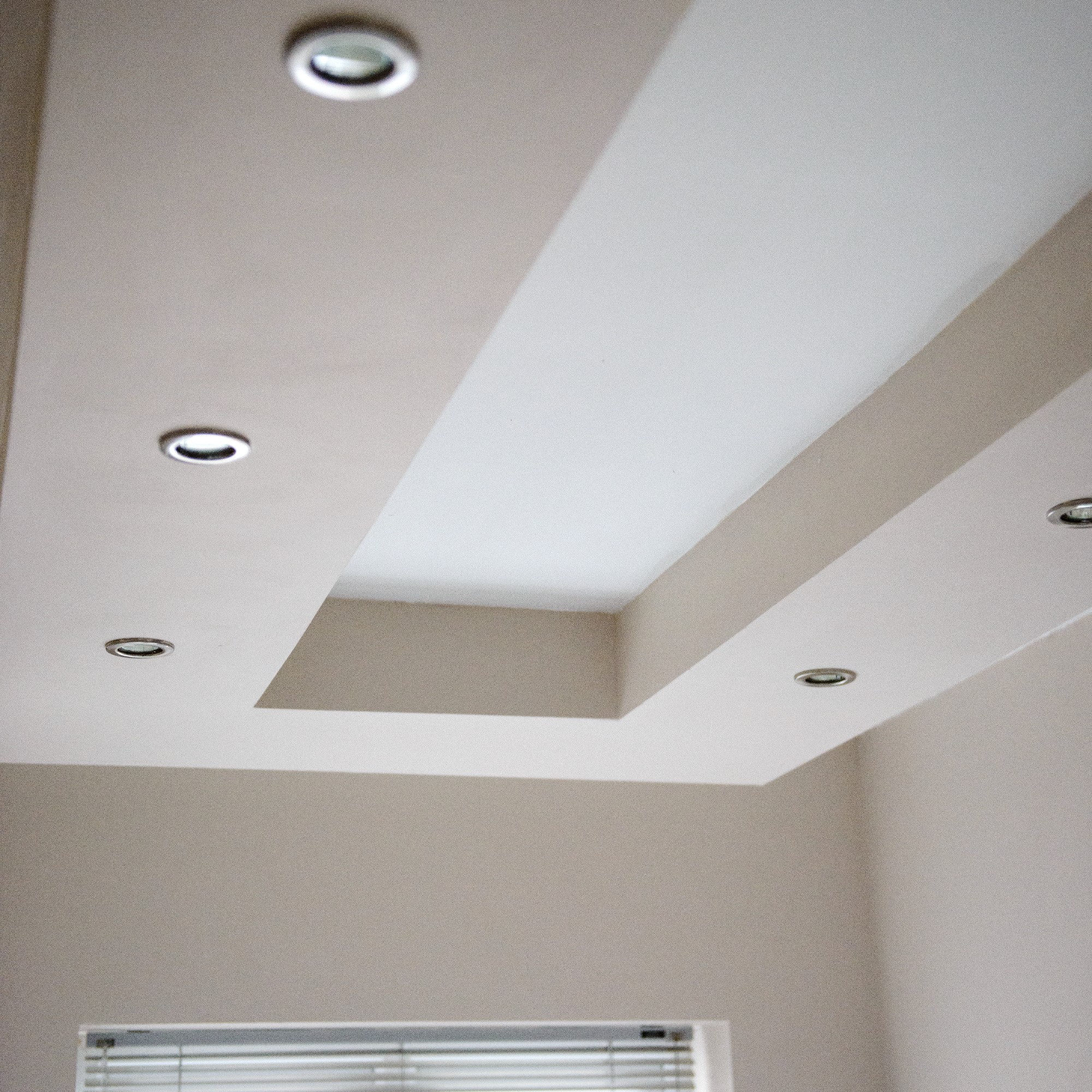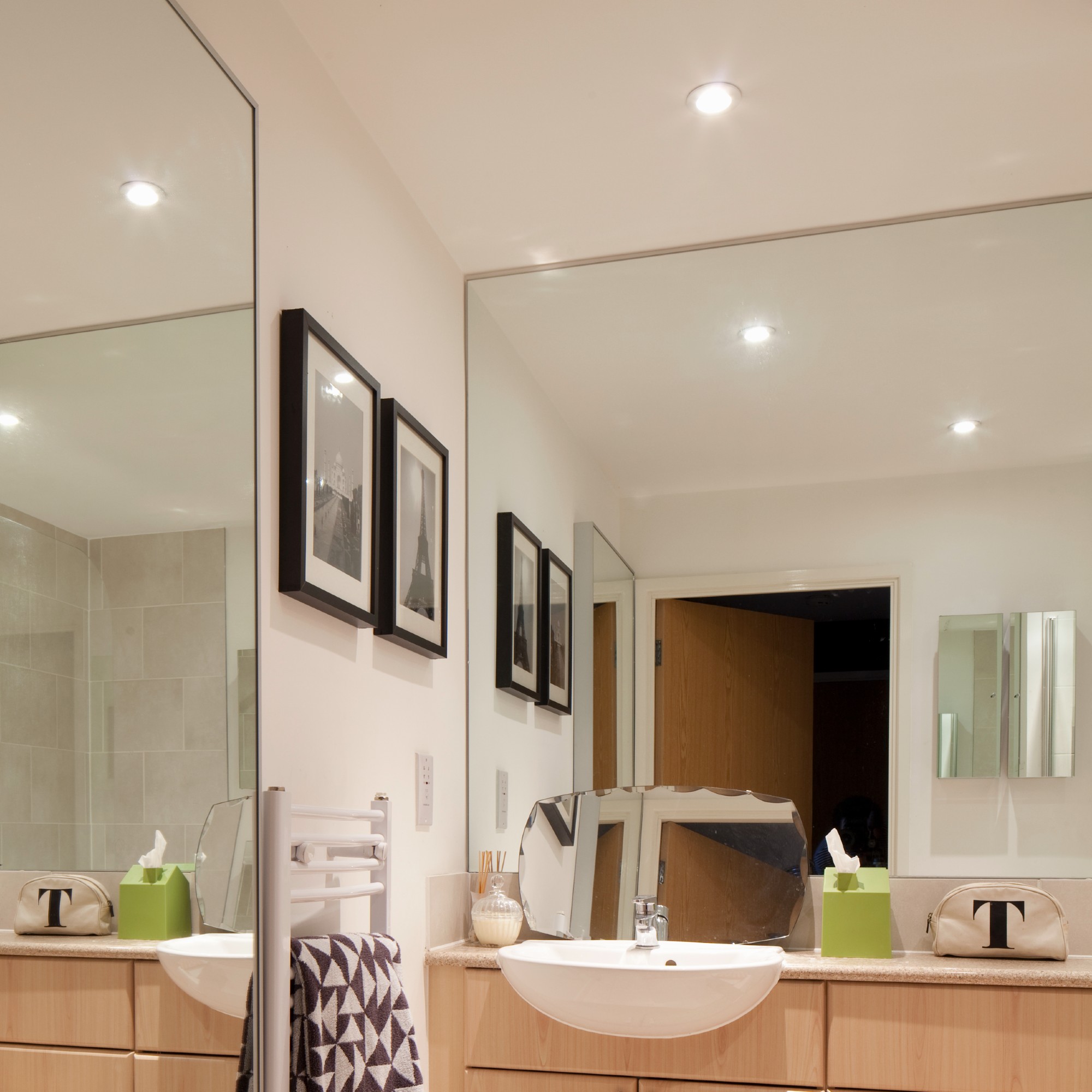
We all know what spotlights are, don’t we? Right?! Well, it turns out that we may have been wrong all along as some of the lighting fixtures we often refer to as spotlights are in fact downlights. So to put the confusion to bed once and for all we’re going to get to the bottom of what the difference is between downlights and spotlights.
As they both make for excellent ceiling kitchen lighting ideas (among others), it is no surprise they often get mistaken for one another – the most common mistake is referring to downlights as spotlights.
You might be wondering what’s the issue with calling one thing another, but it matters as Julian Page, head of design at BHS, explains, ‘Spotlights and downlights can sometimes be mistaken for each other due to their similar appearance, but their distinct functions set them apart. Understanding their differences helps avoid confusion when choosing the right lighting for your space.’

Downlights vs spotlights
So to avoid further confusion, our experts explain what downlights are and what you’d call a spotlight, as well as when and where you should be using each of them to avoid any kitchen lighting mistakes.
What are downlights?
Two of the main identifiers of downlights are that they are recessed into the ceiling and they are fixed in place without the option to move or angle them.
‘Downlights are recessed ceiling lights designed to provide broad ambient lighting and they can only be used indoors,’ says Matthew Currington, technical director at The Lighting Superstore. ‘Downlights are recessed into the ceiling for a seamless look and are not meant to stand out. They provide widespread and diffused light from above to create a general ambience around the room. However, these are fixed in position, so don’t offer flexibility for the direction of the light.’
Their discreet appearance is one of their most attractive features, ‘A downlight is often a light bulb set in a metal cylinder - usually a pressed steel or cast aluminium can - which is installed into the ceiling,’ says Marlena Kaminska, designer at ValueLights.

Where to use downlights
As already mentioned, the kitchen is a great place to install downlights. ‘Functionality is one of the key appeals of downlights, especially when used in a kitchen space. Placing ceiling downlights uniformly above key task zones in your kitchen (for example, your worktops and sink) ensures an even spread of illumination for preparing and cooking food,’ Marlena says.
But that’s not the only area that can benefit from downlights – they also make a great bathroom lighting idea. ‘Downlights are a popular choice for bathrooms, where their recessed design helps to minimise clutter and provides sufficient lighting for daily grooming tasks,’ Julian suggests.
But even if you’re after an efficient hallway lighting idea, downlights can be the ideal choice. ‘Downlights are highly recommended for areas with low ceilings, such as basements or hallways, where space is limited, and a streamlined look is desired. They provide excellent general illumination, evenly spreading light across the room without the intrusion of visible fixtures,’ Julian concludes.

Our favourite downlights
Even though downlights are very discreet, you can still show attention to detail by choosing a beautiful finish like this antique brass.
For a seamless look with lights almost disappearing into the ceiling, opt for white downlights on a white ceiling.
For a modern finish, go for matte black downlights like these best-selling B&Q ones.
What are spotlights?
On the other hand, spotlights make themselves known as they are a lot more visible than downlights.
‘Spotlights emit a focused, narrow beam to illuminate specific areas, objects, or architectural details. They are also flexible and stand out as decorative lighting features which can be adjusted and directed in any direction desired,’ Matthew says.
They can come in several different variations - they are sold as individual lights, as well as a cluster of three or on a track arranged in a line. And unlike downlights, they can be mounted on walls as well as on ceilings. And you can purchase spotlights suitable for outdoor use as they make a fantastic garden lighting idea.

Where to use spotlights
As we just mentioned, spotlights can be a great choice for your outdoor space. ‘Spotlights are commonly used outdoors to accentuate large trees or light up decking and driveways,’ Matthew says.
When it comes to the home indoors, there are several areas where you can install accent lighting like spotlights. ‘Spotlights should be used in areas where accent lighting is desired or where specific items are to be accentuated such as a piece of art or an architectural feature like a beautiful staircase in a hallway,’ Matthew suggests.
Julian adds, ‘In utility rooms, where consistent illumination is paramount, spotlights shine. They offer uniform light distribution across the entire space, ensuring that every corner is well-lit for efficient task completion.’
‘The kitchen is another area where spotlights excel, particularly for task lighting. Properly placed spotlights eliminate frustrating shadows, ensuring that countertops and workspaces are well-lit for meal preparation and cooking. By aligning spotlights with the edge of countertops and adjusting them towards the centre of the room, you can effectively banish shadows and create an optimal lighting environment,’ he concludes.
Our favourite spotlights
Similarly to the black matte downlights, these spotlights with the same finish convey a modern, urban aesthetic. But this six-light fixture is more of a statement feature that we think would look stunning above a kitchen island.
Spotlights can also be installed individually like this design that is more reminiscent of a downlight than the others. And it has the advantage of rotatable light bulb to point in any direction you're looking to illuminate.
As you can probably tell, we currently have a thing for an antique brass finish. It just looks so stylish and elegant on anything from taps to light fixtures like this triple spotlight, arranged in a cluster.
FAQ
How many downlights do I need?

The amount of downlights will differ from how many spotlights you’ll need. Here, uniformity is key.
‘The main thing to consider when installing downlights is spacing as you’ll want to ensure uniform illumination. Evenly place downlights to ensure every nook and cranny is consistently illuminated,’ Marlena says.
Matthew continues with more specific measurements, ‘To avoid having patchy uneven lighting, the general rule is to have one downlight per 1 to 1.5 metres squared, depending on the budget. It is important to remember to leave half a metre between the light and the wall to avoid light being blocked off and creating an odd downward cast of light down the wall.’
We bet that from now on, you’ll never mistake a downlight for a spotlight ever again.







